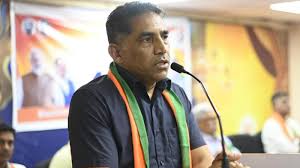CM mentioned there was pressure from Nadda: Govind Gaude’s claim after ouster from Goa Cabinet

The removal of Govind Gaude from the Goa Cabinet has sent shockwaves across the state’s political spectrum. His claim—that BJP national president J.P. Nadda pressured Chief Minister Pramod Sawant to remove him—has turned a routine reshuffle into a major controversy. This development sheds light on deeper issues, including the role of central leadership, internal BJP tensions, and the consequences of raising corruption concerns.
The Spark That Lit the Fuse
It all began on May 25, during the Prerna Divas event, where Gaude made a bold allegation. He pointed to irregularities in the Tribal Welfare Department, which is directly overseen by CM Sawant. According to Gaude, files related to tribal contractors were being cleared “secretly,” bypassing standard procedures. His remarks triggered a strong reaction from within the government.
Just two days later, CM Sawant warned ministers against making such public accusations. Although no action was taken immediately, the message was clear—Gaude had crossed a line.
On June 18, the situation escalated. Gaude received a phone call from the Chief Minister, asking for his resignation. He later revealed that Sawant cited pressure from the BJP’s central leadership—specifically from Nadda—as the reason. That same day, a government notification confirmed Gaude’s removal. The timing—on Goa Revolution Day, a day symbolizing resistance—added symbolic weight to the move.
Gaude’s Public Counterattack
Gaude chose to speak out four days later at a public gathering organized by his supporters under the Priol Pragati Manch. He insisted his dismissal was politically motivated, not disciplinary. Furthermore, he accused the Chief Minister of misleading the public by later stating that the decision was his alone, contradicting his earlier comments about pressure from Delhi.
Despite the setback, Gaude made it clear he hadn’t abandoned the BJP. He reaffirmed his loyalty to Prime Minister Narendra Modi and the party’s vision. In an unusual step, he wrote letters to President Droupadi Murmu, PM Modi, Home Minister Amit Shah, and Nadda. These letters outlined the sequence of events and urged the leadership to review the decision.
Signs of a Deeper Party Divide
The incident has exposed the centralized nature of decision-making within the BJP. Many political observers believe that the delay in removing Gaude stemmed from the need for clearance from Delhi. In effect, Goa’s state leadership appeared to be waiting for instructions before taking action.
Unusually, Gaude named Nadda directly. Ministers rarely implicate national figures in state-level decisions, especially after their removal. This act suggests a deeper frustration and may also be a strategy to trigger a response from the top.
CM Sawant’s Calculated Move
While CM Sawant cited “discipline” as the reason for Gaude’s dismissal, critics see it differently. The Tribal Welfare Department—at the heart of Gaude’s allegations—is under Sawant’s own control. By removing the minister who questioned its functioning, the government has only intensified public scrutiny.
Moreover, the lack of internal resolution before resorting to a dismissal indicates a failure in managing dissent constructively. Instead of addressing the issue transparently, the leadership chose a path that appears punitive.
What’s Next for Gaude?
Although no longer a minister, Gaude remains a key figure in Priol, especially among tribal voters. The creation of Priol Pragati Manch suggests he’s mobilizing support independently, even while staying within the BJP for now. This dual strategy might offer him leverage—either to negotiate a return or to launch a new political front if needed.
For the moment, he continues to express loyalty to the party. However, his strong grassroots backing gives him a degree of political freedom that few sidelined leaders enjoy.
Wider Impact on Goa Politics
This controversy has several long-term implications. Firstly, it has brought public attention to issues of transparency and ministerial accountability. Voters may begin to question how whistleblowers are treated within ruling parties.
Secondly, the situation underscores the top-down approach that defines the BJP’s internal functioning. While this may ensure control, it also risks alienating regional leaders and stifling legitimate concerns.
Thirdly, the Opposition has seized this opportunity. The Congress and Goa Forward Party have accused the BJP of misusing power and suppressing truth. They’ve also warned that such actions could damage the party’s image ahead of upcoming local elections.
Conclusion
Govind Gaude’s removal is no ordinary Cabinet reshuffle. It reflects the tension between loyalty and honesty within political parties. His case highlights how raising concerns—particularly about corruption—can come at a cost. At the same time, it shows that sidelined leaders can still shape public discourse if they command local support.
Whether Gaude regains his place or forges a new path, the events surrounding his ouster will continue to influence Goa’s political narrative. As the state moves closer to elections, both the BJP and its rivals will have to deal with the fallout—and the public’s growing demand for transparency.






